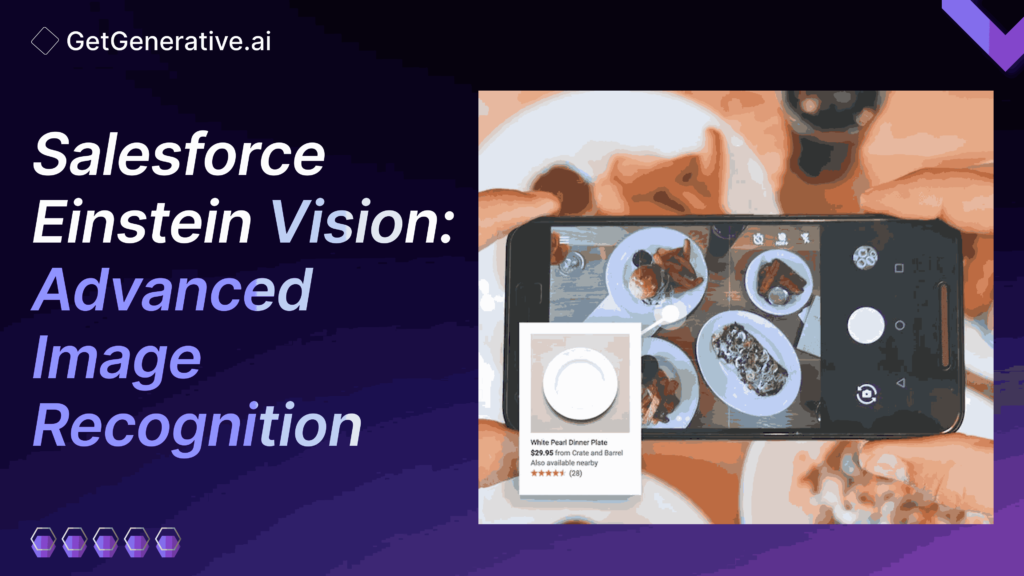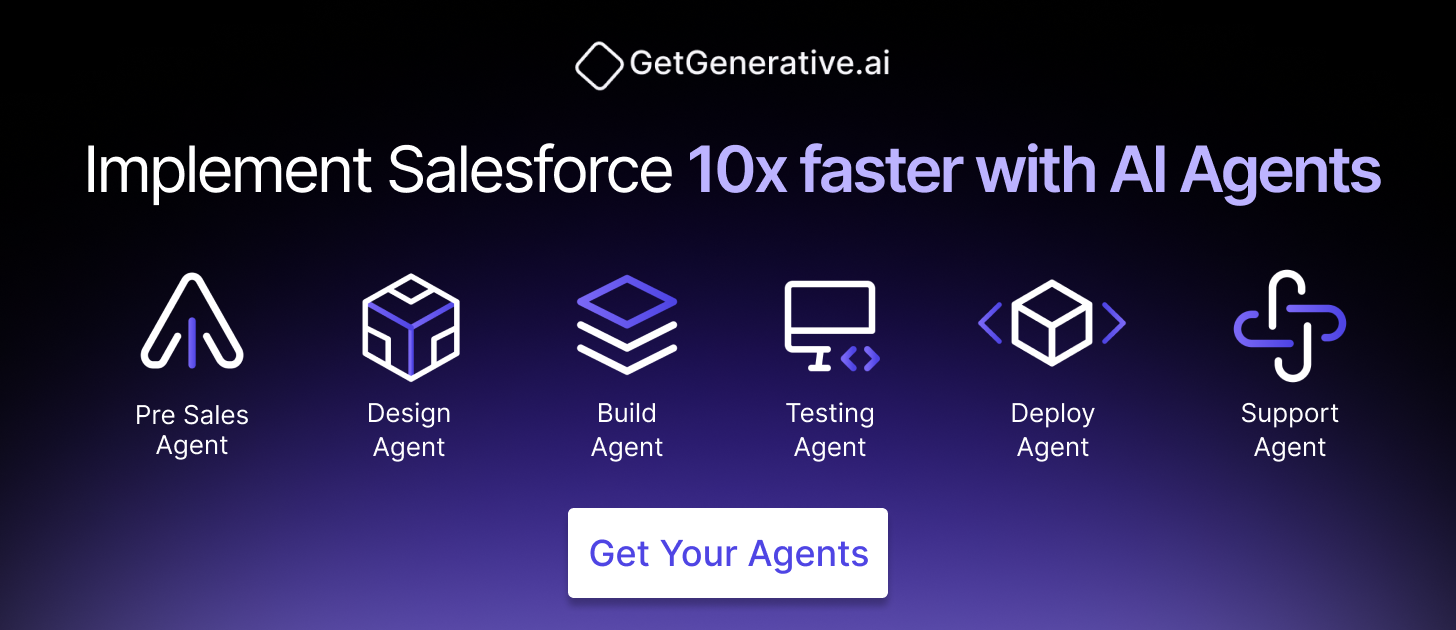Salesforce Einstein Vision: Advanced Image Recognition
A recent market analysis shows that the Image Recognition market is projected to reach US$13.72bn. This substantial growth highlights the increasing adoption of AI technologies like Einstein Vision in healthcare, retail, and manufacturing.
This blog post explores Einstein Vision, outlining its functionalities, implementation strategies, and benefits, particularly in image classification, providing businesses with the tools to stay ahead in a rapidly evolving market.
What is Einstein Vision?
Einstein Vision is part of Salesforce Einstein’s suite of AI capabilities, which harnesses the power of machine learning (ML) to provide advanced image recognition functionalities. It allows businesses to unlock new insights from their visual data, enabling automated image-based analysis and decision-making. By integrating this technology, companies can streamline operations, enhance customer engagement, and boost productivity.
How does Einstein Vision work?
Einstein Vision leverages advanced machine learning techniques, specifically convolutional neural networks (CNNs), to analyze and classify images. This section breaks down the process into a more detailed exploration of how these models operate within the Salesforce ecosystem:
Model Training
- Data Input: Users begin by inputting a large set of labeled images. These images serve as the foundational data from which the model will learn.
- Feature Learning: The CNNs automatically detect and learn features from these images without needing explicit programming for each feature. This can include anything from simple edges and textures to complex objects like faces or logos.
Image Processing
- Layered Analysis: CNNs process images in layers. The first layer might detect simple features like colors and edges, while deeper layers recognize more complex features such as shapes or specific objects.
- Activation Functions: These functions in the neural network help decide which features are important by introducing non-linearities into the model, which helps to decide which features contribute to a specific classification.
Classification
- Output Layer: The final layer in a CNN provides the classification output. Here, the network uses all the learned features to classify new images according to the categories it has been trained on.
- Probability Scores: For each category, the model outputs a probability score that indicates how likely it is that the image belongs to that category.
Integration with Salesforce
- APIs: Einstein Vision is integrated into Salesforce through APIs, allowing users to seamlessly connect their image recognition models with their CRM data.
- Real-time Processing: The integration facilitates real-time image processing, enabling immediate application in business processes such as customer service, marketing campaigns, and product sorting.
Also Read – Top Salesforce AI Tools 2025 – The Ultimate List
Salesforce Einstein AI Capabilities
Salesforce Einstein extends its AI capabilities beyond image recognition, integrating a comprehensive suite of tools that enhance various facets of customer relationship management. This section details how these functionalities synergize to provide a robust, intelligent CRM platform:
Predictive Analytics
- Lead Scoring: Automatically scores leads based on how likely they are to convert, enabling sales teams to prioritize their efforts more effectively.
- Opportunity Insights: This service provides sales representatives with recommendations on the best steps to close deals based on the analysis of past sales data.
Natural Language Processing (NLP)
- Einstein Language: Comprises tools like Einstein Intent, which understands the underlying intent behind text from emails or social media posts, and Einstein Sentiment, which gauges the sentiment expressed in the text.
- Automated Service Bots: Uses NLP to interact with customers, understand their queries, and provide instant responses, enhancing customer service operations.
Automated Recommendation Systems
- Einstein Recommendations: Uses machine learning to personalize product recommendations for each customer based on their browsing and purchase history.
- Next Best Action: Suggests the most effective actions that service agents can take while interacting with customers based on predictive analytics and business rules.
Data Integration and Insights
- Einstein Discovery: An AI-powered analytics tool that automatically finds patterns in the data, explains insights through easy-to-understand stories and even makes predictions to aid decision-making processes.
- Integration with Tableau: Enhances data visualization capabilities, allowing businesses to see and understand data in sophisticated, customizable dashboards that support data-driven decisions.
“By next year, AI could be smarter than all humans.”
– Dario Amodei, CEO of Anthropic
How to Implement Einstein Vision in Salesforce?
Implementing Einstein Vision within Salesforce involves a structured approach that integrates seamlessly with your existing data and processes. Here’s a step-by-step guide on how to deploy Einstein Vision effectively:
Preparation and Data Collection
- Gather Data: Collect a comprehensive set of images you want to classify. This dataset should be varied and large enough to train a robust model.
- Label Data: Ensure each image is accurately labeled with tags that describe its content. This step is crucial for training the model to recognize and classify images correctly.
Model Training and Development
- Select a Model: You can choose between Salesforce’s pre-built AI models or developing a custom model tailored to your specific needs.
- Train the Model: Use Salesforce’s Einstein Vision APIs to upload your image dataset and train your model. During this phase, the model learns to recognize patterns and features that differentiate the categories of your images.
- Validate the Model: After training, validate the model with a separate set of images to ensure it performs well and makes accurate classifications.
Also Read – Salesforce Einstein Intent: A Comprehensive Guide
Integration with Salesforce
- API Integration: Utilize Salesforce’s RESTful APIs to integrate the trained model into your Salesforce environment. This allows you to automate image classification directly within your CRM workflows.
- Setup Triggers and Actions: Configure Salesforce workflows to trigger image classification at appropriate points, such as when new image data is uploaded to your CRM system.
Deployment and User Training
- Deploy the Model: Once integrated and tested, deploy the model for live operations and ensure that it operates efficiently within the broader Salesforce ecosystem.
- User Training: Educate your team on how to use and benefit from Einstein Vision. Include training on uploading images, interpreting classification results, and leveraging these insights for business decisions.
Monitoring and Optimization
- Monitor Performance: Continuously monitor the model’s performance to ensure it remains accurate over time. Be aware of any shifts in data patterns that might require retraining the model.
- Optimize and Update: Regularly update the model with new data and fine-tune it to adapt to any business operations or objectives changes.
What are the Key Benefits of Using Einstein Vision for Image Classification?
The adoption of Einstein Vision for image classification offers multiple benefits:
- Enhanced Accuracy: AI-driven tools provide more accurate classifications compared to manual processes.
- Scalability: Easily scale your image classification tasks as your dataset grows without needing to increase human resources.
- Real-time Analysis: Implement real-time image analysis to make immediate decisions, which is crucial for dynamic business environments.
- Improved Customer Experience: Use image data to better understand customer behaviors and preferences, leading to more personalized services.
Also Read – Salesforce Einstein Language – Unlocking Advanced NLP Capabilities
Practical Use Cases for Einstein Vision Across Industries
Einstein Vision’s advanced image recognition capabilities can be applied across diverse industries, transforming how businesses leverage visual data. Here are some practical use cases demonstrating its versatility:
1. Retail: Enhancing Inventory Management
- Use image recognition to identify stock levels, monitor shelf displays, and detect misplaced items in stores. Automate alerts for low-stock products, ensuring seamless inventory replenishment.
- Example: A clothing retailer scans images of shelves to track product availability and identify fast-moving items.
2. Healthcare: Streamlining Diagnostics
- Deploy Einstein Vision to analyze medical images, such as X-rays or MRI scans, to assist in early detection of diseases and improve diagnostic accuracy.
- Example: A healthcare provider uses image classification to detect anomalies in radiology images, improving early intervention rates.
3. Manufacturing: Quality Assurance
- Leverage AI models to identify defects in production lines by analyzing images of products. This ensures consistency and reduces waste.
- Example: A manufacturer uses Einstein Vision to inspect electronic components for defects during assembly.
4. E-commerce: Visual Search and Recommendations
- Enhance customer experience by enabling visual search functionalities. Customers can upload an image, and the platform will suggest similar products from the catalog.
- Example: An online store integrates Einstein Vision to let users find matching outfits by uploading pictures.
5. Agriculture: Crop Monitoring
- Use image recognition to monitor crop health by identifying signs of pest infestation, diseases, or nutrient deficiencies through drone or satellite imagery.
- Example: A farm management company analyzes aerial images to predict yields and optimize resource allocation.
6. Insurance: Accelerating Claims Processing
- Automate claim evaluations by analyzing images of damages submitted by customers, reducing manual effort and processing time.
- Example: An insurance provider processes car accident claims by using Einstein Vision to assess vehicle damage from uploaded photos.
7. Travel and Hospitality: Improving Guest Experiences
- Analyze images from customer reviews or social media to understand trends, preferences, and areas for improvement in guest services.
- Example: A hotel chain uses image analysis to categorize and respond to guest feedback containing visual content.
Conclusion
Einstein Vision by Salesforce represents a transformative approach to handling and analyzing visual data. By integrating AI capabilities within their CRM system, businesses can enhance operational efficiency, improve customer interactions, and drive innovation. Regardless of size, companies can leverage Einstein Vision to harness the full potential of their visual data and make smarter, data-driven decisions.
Streamline Your Consulting with GetGenerative.ai. Craft impressive proposals swiftly, allowing you to dedicate more time to delivering exceptional client service.
Get started Now!
Frequently Asked Questions (FAQs)
1. Does implementing Einstein Vision require AI expertise?
Thanks to Salesforce’s user-friendly platform and comprehensive documentation, basic implementation can be managed without deep AI expertise. However, AI knowledge may be beneficial for more advanced customizations.
2. What types of images can Einstein Vision analyze?
Depending on the trained model’s focus, Einstein Vision can analyze various image types, including product images, photographs from events, and more.
3. Is Einstein Vision expensive to implement?
The cost can vary depending on the scale of implementation and the specific business requirements. Salesforce offers different pricing tiers that can accommodate the needs of different business sizes, including small businesses.




